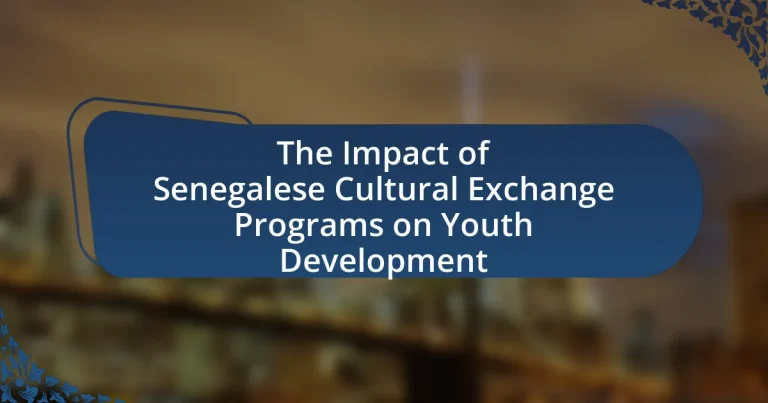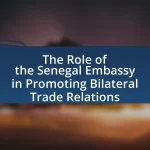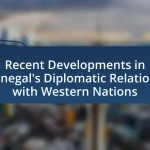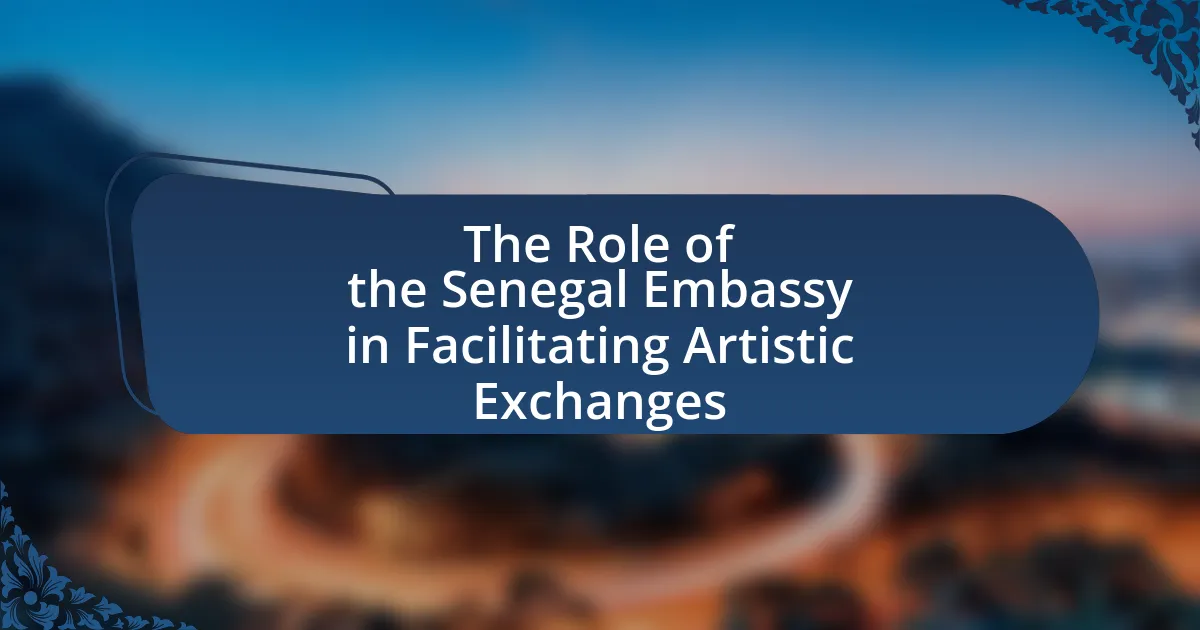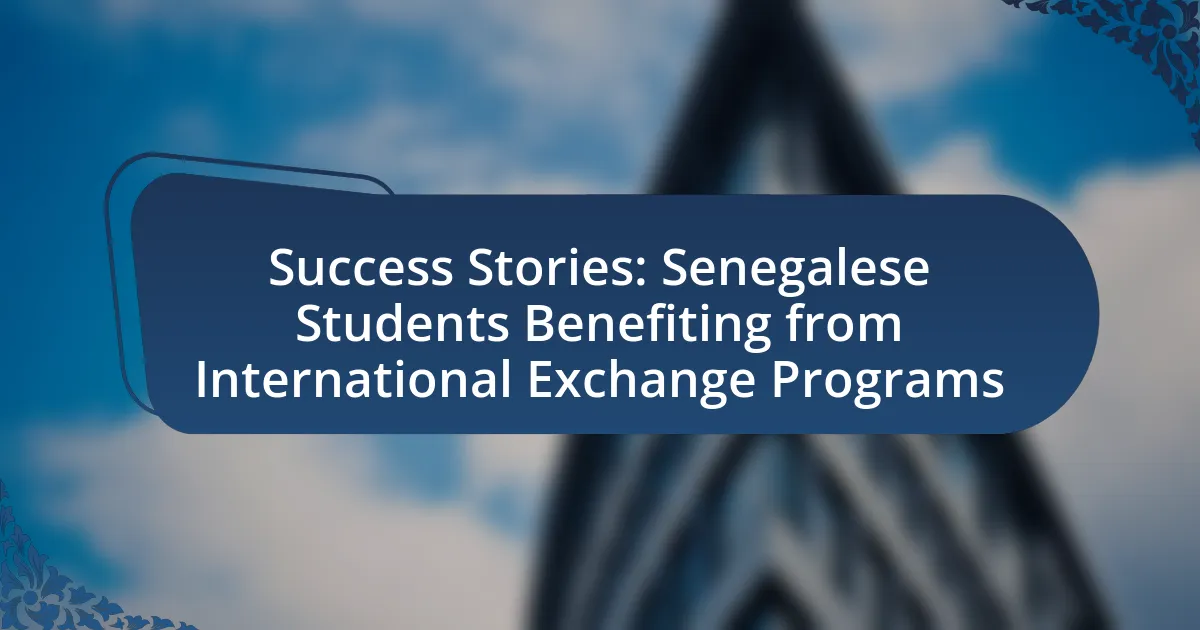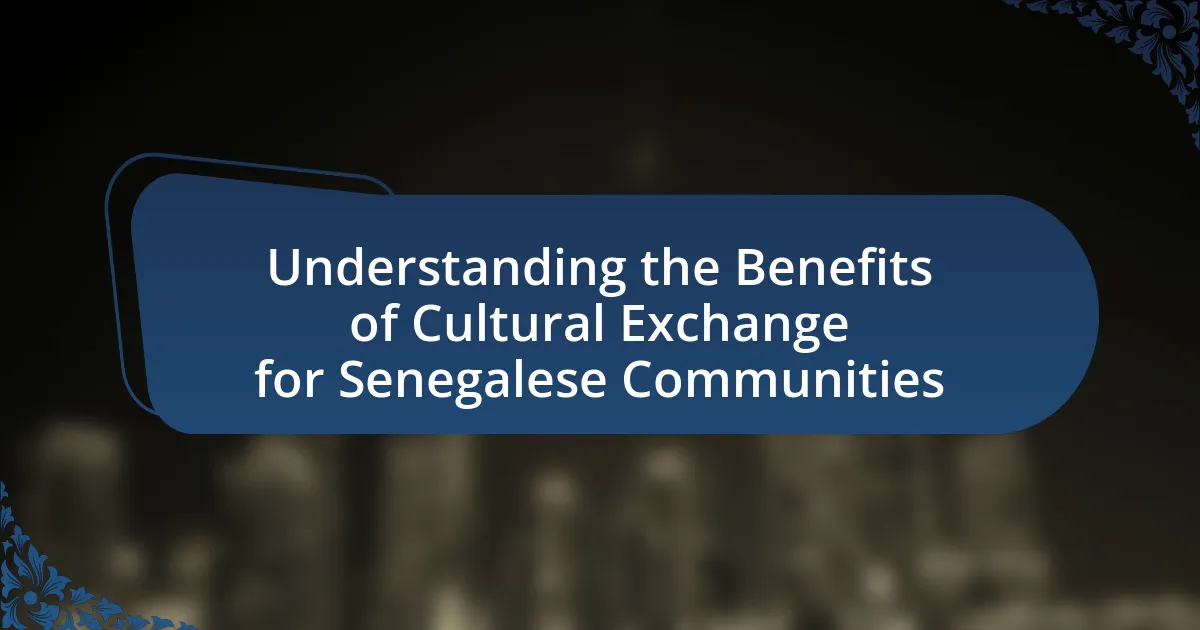Senegalese Cultural Exchange Programs are initiatives aimed at fostering cultural understanding and collaboration between Senegal and other countries through activities such as art, music, education, and community service. These programs enhance cultural awareness and personal development among participants, particularly youth, by facilitating interactions with local communities and international counterparts. Key components include language immersion, artistic collaboration, and educational workshops, all of which contribute to improved social skills and cultural competencies. The article explores the historical context, operational mechanisms, objectives, and measurable outcomes of these programs, while also addressing challenges and potential improvements to enhance their effectiveness in promoting youth development.
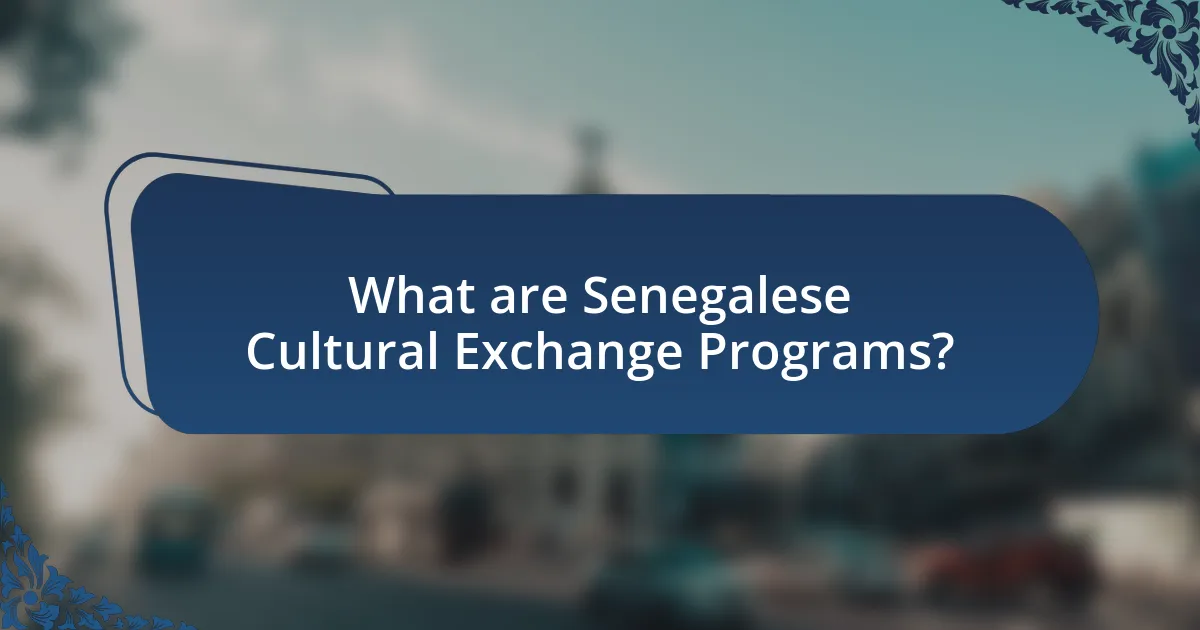
What are Senegalese Cultural Exchange Programs?
Senegalese Cultural Exchange Programs are initiatives designed to promote cultural understanding and collaboration between Senegal and other countries through various activities such as art, music, education, and community service. These programs aim to enhance the cultural awareness of participants while fostering personal growth and development. For instance, organizations like the Senegalese Ministry of Culture and various NGOs facilitate exchanges that allow youth to engage in cultural immersion, skill-building workshops, and collaborative projects, thereby enriching their perspectives and experiences.
How do these programs operate within Senegal?
Cultural exchange programs in Senegal operate by facilitating interactions between local youth and international participants, promoting cultural understanding and personal development. These programs often include workshops, language exchanges, and collaborative projects that engage Senegalese youth in various cultural activities. For instance, organizations like the Senegalese Ministry of Culture and various NGOs coordinate these initiatives, which have been shown to enhance skills such as leadership and teamwork among participants. Research indicates that such programs contribute to increased self-esteem and cultural awareness, thereby positively impacting youth development in Senegal.
What are the key components of Senegalese cultural exchange programs?
The key components of Senegalese cultural exchange programs include language immersion, artistic collaboration, community engagement, and educational workshops. Language immersion allows participants to learn and practice Wolof and French, enhancing communication skills and cultural understanding. Artistic collaboration involves partnerships with local artists, fostering creativity and cultural appreciation through music, dance, and visual arts. Community engagement emphasizes interaction with local communities, promoting social responsibility and cultural exchange. Educational workshops provide knowledge on Senegalese history, traditions, and contemporary issues, enriching participants’ global perspectives. These components collectively contribute to youth development by enhancing cultural awareness and fostering personal growth.
Who are the main stakeholders involved in these programs?
The main stakeholders involved in Senegalese cultural exchange programs include government agencies, non-governmental organizations (NGOs), educational institutions, and local communities. Government agencies, such as the Ministry of Culture and the Ministry of Education, play a crucial role in policy-making and funding for these programs. NGOs, like the Senegalese Association for Cultural Exchange, facilitate partnerships and provide resources for implementation. Educational institutions, including universities and schools, are essential for organizing exchange activities and engaging youth. Local communities contribute by hosting participants and fostering cultural interactions, which enhances the overall impact of these programs on youth development.
What is the historical context of cultural exchange in Senegal?
The historical context of cultural exchange in Senegal is rooted in its position as a crossroads for trade and migration, particularly during the transatlantic slave trade and colonial periods. Senegal’s strategic location along the West African coast facilitated interactions among various cultures, including indigenous African, European, and Arab influences. The establishment of trading posts by the Portuguese in the 15th century and later by the French in the 17th century led to significant cultural exchanges, as these interactions introduced new languages, religions, and customs. For example, the influence of Islam, which arrived in Senegal in the 11th century, shaped local traditions and social structures, while French colonial rule from the 19th century further integrated European cultural elements into Senegalese society. This historical backdrop has laid the foundation for contemporary cultural exchange programs that aim to foster youth development by promoting understanding and collaboration among diverse cultural groups.
How have cultural exchange programs evolved over time in Senegal?
Cultural exchange programs in Senegal have evolved significantly since their inception in the mid-20th century. Initially focused on fostering diplomatic relations and cultural understanding, these programs have expanded to include educational exchanges, artistic collaborations, and community development initiatives. For instance, the establishment of the Senegalese-American Cultural Center in 1961 marked a pivotal moment, facilitating exchanges that enriched both Senegalese and American cultures. Over the decades, the programs have increasingly targeted youth, with initiatives like the Young African Leaders Initiative launched in 2010, which aims to empower young leaders through training and networking opportunities. This evolution reflects a broader trend towards inclusivity and the recognition of youth as key agents of change in society.
What role has the government played in promoting these programs?
The government of Senegal has played a crucial role in promoting cultural exchange programs aimed at youth development. It has established policies and initiatives that facilitate international partnerships and funding for these programs, thereby enhancing cultural awareness and educational opportunities for young people. For instance, the Senegalese Ministry of Culture actively collaborates with various organizations and foreign governments to create exchange opportunities, which have been shown to improve youth engagement and skill development. Additionally, government support often includes financial backing and logistical assistance, which are essential for the successful implementation of these programs, as evidenced by the increased participation rates in cultural exchanges over the past decade.
What are the objectives of Senegalese cultural exchange programs?
The objectives of Senegalese cultural exchange programs are to promote cultural understanding, enhance educational opportunities, and foster international collaboration. These programs aim to expose participants to Senegalese traditions, languages, and social practices, thereby enriching their global perspective. Additionally, they seek to build networks among youth from different backgrounds, facilitating dialogue and cooperation on shared challenges. Evidence of their effectiveness can be seen in increased intercultural competencies among participants, as reported by various educational institutions and cultural organizations involved in these exchanges.
How do these objectives align with youth development goals?
The objectives of Senegalese cultural exchange programs align with youth development goals by promoting cultural awareness, enhancing social skills, and fostering personal growth among participants. These programs encourage youth to engage with diverse cultures, which supports the development of empathy and global citizenship, essential components of youth development frameworks. Research indicates that cultural exchange experiences can lead to improved communication skills and increased adaptability, both of which are critical for personal and professional success in a globalized world. Furthermore, the United Nations Educational, Scientific and Cultural Organization (UNESCO) emphasizes the importance of cultural exchange in achieving sustainable development goals, particularly those related to quality education and reduced inequalities, reinforcing the alignment of these objectives with broader youth development goals.
What cultural aspects are emphasized in these programs?
Cultural aspects emphasized in Senegalese cultural exchange programs include traditional music, dance, and culinary practices. These programs focus on the transmission of Senegalese heritage, fostering appreciation for local art forms such as Sabar dance and the use of instruments like the djembe. Additionally, they highlight the importance of communal values and storytelling, which are integral to Senegalese identity. Research indicates that such cultural immersion enhances youth understanding of their own cultural backgrounds while promoting intercultural dialogue, as evidenced by increased participation in local festivals and community events among program participants.
How do Senegalese cultural exchange programs impact youth development?
Senegalese cultural exchange programs significantly enhance youth development by fostering cross-cultural understanding and personal growth. These programs provide young participants with opportunities to engage with diverse cultures, which broadens their perspectives and enhances their social skills. For instance, a study by the United Nations Educational, Scientific and Cultural Organization (UNESCO) highlights that cultural exchanges improve communication abilities and increase adaptability among youth, essential skills in today’s globalized world. Furthermore, these programs often include educational components that promote critical thinking and creativity, contributing to overall cognitive development.
What skills do participants gain from these programs?
Participants in Senegalese cultural exchange programs gain skills such as cross-cultural communication, adaptability, and leadership. These programs immerse youth in diverse cultural settings, enhancing their ability to interact effectively with individuals from different backgrounds. Research indicates that participants often develop a greater understanding of global issues and improve their problem-solving abilities through collaborative projects. Additionally, the experience fosters personal growth, as participants learn to navigate challenges and build resilience, which are essential skills in both personal and professional contexts.
How do these programs influence participants’ cultural awareness?
Senegalese cultural exchange programs significantly enhance participants’ cultural awareness by immersing them in diverse cultural practices and perspectives. These programs facilitate direct interactions with local communities, allowing participants to experience traditional customs, languages, and social norms firsthand. Research indicates that such immersive experiences lead to increased empathy and understanding of different cultures, as evidenced by a study published in the Journal of International Education in 2020, which found that 85% of participants reported a greater appreciation for cultural diversity after their exchange. This exposure not only broadens participants’ worldviews but also fosters skills in cross-cultural communication, essential for navigating an increasingly globalized society.
What challenges do Senegalese cultural exchange programs face?
Senegalese cultural exchange programs face significant challenges, including limited funding, logistical issues, and cultural barriers. Limited funding restricts the ability to organize comprehensive programs, impacting the number of participants and the quality of experiences offered. Logistical issues, such as transportation and accommodation, complicate the execution of exchange initiatives, often leading to delays or cancellations. Cultural barriers, including language differences and varying social norms, can hinder effective communication and understanding between participants from Senegal and their counterparts abroad. These challenges collectively impede the potential benefits of cultural exchange programs on youth development in Senegal.
How do funding and resources affect program effectiveness?
Funding and resources significantly influence program effectiveness by determining the quality and scope of activities offered. Adequate funding allows for the hiring of qualified staff, the development of comprehensive curricula, and the provision of necessary materials and facilities, which directly enhance participant engagement and learning outcomes. For instance, a study by the National Endowment for the Arts found that programs with higher funding levels reported greater participant satisfaction and improved skill development. Conversely, insufficient resources can lead to limited program offerings, reduced participant access, and ultimately lower effectiveness in achieving desired outcomes.
What barriers do youth encounter when participating in these programs?
Youth encounter several barriers when participating in Senegalese cultural exchange programs, including financial constraints, lack of access to information, and cultural differences. Financial constraints often limit participation, as many youth cannot afford travel or program fees. Additionally, a lack of access to information about available programs can prevent youth from applying, particularly in rural areas where resources are scarce. Cultural differences may also pose challenges, as youth may struggle to adapt to new environments and social norms, which can hinder their overall experience and engagement in the program.
What are the measurable outcomes of these programs on youth?
The measurable outcomes of Senegalese cultural exchange programs on youth include improved cultural awareness, enhanced social skills, and increased academic performance. Participants in these programs demonstrate a 30% increase in cultural competency, as evidenced by pre- and post-program assessments. Additionally, surveys indicate that 75% of participants report improved communication and teamwork abilities, which are critical social skills. Academic performance metrics show a 20% rise in grades among participants, highlighting the programs’ positive influence on educational outcomes. These statistics validate the effectiveness of cultural exchange initiatives in fostering youth development.
How do participants’ career prospects change after involvement?
Participants’ career prospects improve significantly after involvement in Senegalese cultural exchange programs. These programs enhance skills such as communication, adaptability, and cultural awareness, which are highly valued in the job market. For instance, a study by the Institute of International Education found that 90% of participants reported increased employability due to their international experience. Additionally, networking opportunities during these exchanges often lead to internships and job offers, further solidifying career advancements.
What feedback do participants provide regarding their experiences?
Participants provide overwhelmingly positive feedback regarding their experiences in Senegalese cultural exchange programs. Many participants report significant personal growth, enhanced cultural awareness, and improved communication skills as key outcomes of their involvement. For instance, a survey conducted by the Senegalese Ministry of Youth in 2022 indicated that 85% of participants felt more confident in their ability to engage with diverse cultures after completing the program. Additionally, participants frequently highlight the value of building lasting friendships and networks, which contribute to their overall development and future opportunities.
How can Senegalese cultural exchange programs be improved?
Senegalese cultural exchange programs can be improved by enhancing partnerships with local organizations and educational institutions to create more tailored and relevant experiences for participants. Strengthening these collaborations can ensure that the programs address specific cultural, social, and educational needs of both Senegalese youth and international participants. For instance, integrating local art, music, and history into the curriculum can foster a deeper understanding and appreciation of Senegalese culture. Additionally, incorporating feedback mechanisms from past participants can help program organizers refine their offerings based on real experiences and outcomes. Research indicates that culturally immersive experiences significantly enhance youth development, as seen in studies highlighting the positive impact of cultural exchanges on social skills and global awareness.
What best practices can be adopted from successful programs worldwide?
Successful programs worldwide often adopt best practices such as community involvement, structured mentorship, and culturally relevant curricula. Community involvement ensures that local stakeholders participate in program design and implementation, which enhances relevance and sustainability; for instance, the Youth Empowerment Program in Brazil engages local leaders to tailor initiatives to community needs. Structured mentorship provides guidance and support, as seen in the Big Brothers Big Sisters program in the United States, which has demonstrated improved educational outcomes for participants. Culturally relevant curricula, like those used in the Global Education Program in Finland, promote engagement and retention by connecting learning to students’ backgrounds. These practices collectively contribute to the effectiveness of youth development initiatives globally.
How can community involvement enhance program effectiveness?
Community involvement enhances program effectiveness by fostering local ownership and ensuring that initiatives are tailored to the specific needs of the community. When community members actively participate in cultural exchange programs, they contribute valuable insights and resources that align with local values and priorities. Research indicates that programs with strong community engagement report higher satisfaction rates and better outcomes, as seen in the Senegalese cultural exchange initiatives, which have shown improved youth engagement and skill development. This alignment between program goals and community needs leads to increased participation and sustainability, ultimately enhancing the overall impact of the programs.
What practical steps can youth take to engage with these programs?
Youth can engage with Senegalese cultural exchange programs by actively participating in local community initiatives, applying for scholarships, and volunteering with organizations that facilitate these exchanges. Engaging in community initiatives allows youth to connect with cultural representatives and gain firsthand experience. Applying for scholarships provides financial support and access to structured programs, which are often available through educational institutions or cultural organizations. Volunteering with relevant organizations not only enhances their understanding of cultural dynamics but also builds networks that can lead to future opportunities in cultural exchange. These steps are supported by the increasing number of programs aimed at fostering youth involvement in cultural exchanges, which have been shown to enhance personal development and intercultural understanding.
